Table of Contents
- How to Start a Mining Business for Gold & other Metals
- Health Issues
- Environmental Degradation
- Ore Recovery
- Corporate Social Responsibility
- Southern Peru Gold Belt Analysis
- Small Gold Plant Design
- Plant Operating Cost Estimate
- Fiscal Regime
- Proposed Development Schedule
- Management Team
- Cash Flow Analysis
- Mining Project Risks
The following document outlines a mining business proposal to design and construct a free standing toll plant facility, known in this document as Peru Toll Treatment (PTT), in southern Peru to accommodate the needs of a growing quantity of small scale miners who produce up to 14 percent of the country’s annual gold production. The plan includes the basic design criteria on which the plant will be built, the model for generating revenue and a detailed annual cash flow forecast for the proposed operation for a period of ten years.
The proposed 7.5 tonne per hour plant will cost approximately $2.9 million to design (including $473,000 in VAT taxes which will be reimbursed from revenues), construct and startup and will generate revenues by providing a custom milling facility for small producers who sell their production to the plant. This business opportunity does not include any involvement in mining or the production of mineral. It only involves the purchase and treatment of gold minerals. While the market for such a plant can easily accommodate a 350 tonne per day operation the business plan is based on processing 150 tonnes per day only with the ability to later expand to multiple plants of 350 tonnes per day each.
The plan calls for raising the $2.9 million from public equity financings. Once in operation, the operating company will retain $250,000 for working capital and all subsequent profits will be paid to the shareholders every 3 months as a dividend. The cash flow model is for a single plant of 150 tonnes per day, calculated on an after tax (Peruvian fiscal regime) basis for a 10 year project life. On a project basis using a $1500 per ounce gold price and a discount rate of 10 percent the project will generate a net present value of almost $22.0 million. The payout of the capital investment on a project basis is 1.1 years and the calculated rate of return is over 200%. Testing the project economics against changes in the primary input variables (capital cost, operating cost and gold price) indicates that the project is very robust and even with significant increases in costs or reductions in revenue sources the project has a positive rate of return.
How to Start a Mining Business for Gold & other Metals
Appendix 5 of this Business Plan includes expressions of interest from two formal miners who are 100% owners of their concessions and can offer 450 tonnes per day of production. PTT has visited one of the mines and confirms the potential for a 350 tonne per day operation. In order to facilitate the commencement of mining production PTT intends to rent $100,000 of mining equipment to these owners as part of a preferred mineral provider position. This cost has been included in the project economics.
This Business Plan is based on the construction and operation of 1 plant to demonstrate the profitability of the toll treatment plant concept. During this first year of operation the management will be evaluating expansion opportunities in other areas of the country as well as at the current site. PTT intends to build and operate 4 – 350 tonne per day gold plants in Peru within 5 years and the company will generate an estimated after tax, net cash flow of $40 million per annum.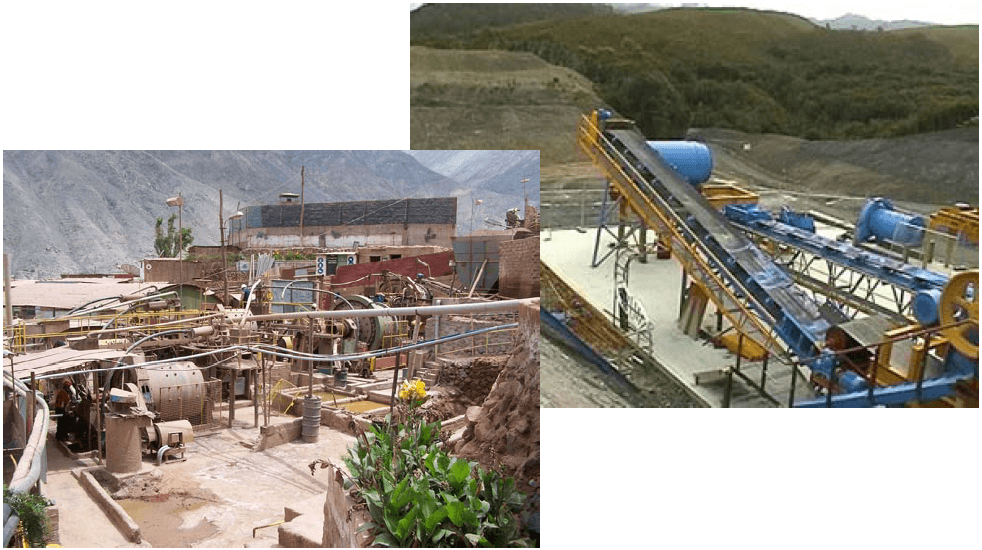
PTT believes that health, environmental and social improvements will accrue to the informal miners in those areas of Peru in which the Company operates and these are important aspects of the expansion phase of the project. Current informal mining practice involves the uncontrolled use of the toxic substances mercury and sodium cyanide to obtain the gold at very low recovery rates. Many of the informal miners are, in effect, stealing the gold from the government or legitimate concession holders causing significant social disruption in the affected areas of the country. It is, therefore, an important aspect of this business plan to reduce the negative health and environmental aspects of informal mining activity by offering an advanced technology which safely removes up to 90% of the gold from the ores resulting in a much higher payback to the people who mine the ore. Purchasing gold ores from informal miners who do not own their concessions is illegal in Peru and rightfully so. It is the intention of PTT to work with informal miners to ensure that they legitimize their activities by entering into registered contracts with the owners of the mineral resources.
There are risks to the project but most can be mitigated by doing appropriate engineering prior to plant design and construction. The plant will use standard gold processing technology and country/political risk is the greatest threat to the project. Peru has signed free trade agreements with both Canada and the United States which is normalizing its business activities.
Overview of Peru
Mineral Wealth
From the days of the Spanish conquest, foreigners have come in search of the products of Peru’s mines and the mining sector has been a core part of the economy up until the modern era. Operations at the historic zinc-mining center of Cerro de Pasco began in 1905 and the Metallurgical Complex at La Oroya started production in 1922. Much of Peru’s rail network was created to serve the needs of the mining industry. Nevertheless, relatively little exploration was carried out in the 1960s and 1970s and development of the mining sector came to a halt. Peru’s favorable geology has been under-exploited and while reserves have been exploited intensively in the US, Canada and Chile, to date only about 12 per cent of Peru’s mineral resources have been identified. Peril has the capacity to double or triple current levels of output, especially in base metals. In all, Peru holds about 16 per cent of the world’s known mineral reserves, including 15 per cent of copper and 7 per cent of zinc reserves.
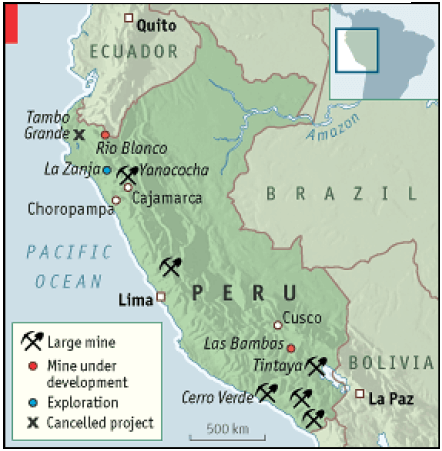
Figure 1 Large Mines and Projects
Mining activity contributes 45% of foreign currency to the national economy which implies investment commitments, promotion of a modern managerial philosophy, increased responsibility towards safety and care of the environment as well as improved rural social development.
While mining provides relatively few jobs, it is vital to Peru’s economy in other ways. Thanks both to high mineral prices and rising output, mineral exports were up by almost half last year, and accounted for 55% of total exports. Mining brings in 29% of total tax revenues. Of this money, the government last year returned $138m as a local royalty to mining areas, most of which are otherwise poor and remote.
As a result of its favourable geology and improving economy Peru is taking a dominant position in the production and sale of many base and precious metals. It occupies first place in Latin America in zinc, tin, lead and gold; second place in silver and copper; fifth in iron. In the context of world mining production, Peru is in fifth place in gold, second place in silver, third place in tin, fourth place in zinc and lead, fifth place in copper and twenty-fifth place in iron as shown on Table 1 below.
Table 1: Peruvian Minerals Production

Business Climate
Since the constitutional and business/economic reforms of the early 1990’s Peru has enjoyed a robust economy with strong economic growth tied closely to the business cycles of its primary metals production. The country allows any person or company to create and own a Peruvian entity and all profits can be repatriated to another jurisdiction free of additional levies.
The tax code is relatively simple and taxes are calculated as 30% of net profits after depreciation. Machinery and equipment are all subject to depreciation on a straight line basis and the majority of items are considered to have a 10 year life. A recently introduced royalty provision requires an additional payment to the government depending upon mine production level – the higher the production level, the higher the royalty to a maximum of 3% of sales. Currently small producers (less than 350 tonnes per day) are exempt from this royalty.
Labour laws are not restrictive and employee burden is approximately 30% of base salary. Unskilled labour is relatively inexpensive and university trained and skilled trades labour are paid commensurate with the level of training. Skilled and professional talent exists in abundance and is of a high quality.
Political Stability
Peru has a long history of political instability. In 1993 Alberto Fujimori enacted several far-reaching legal and constitutional reforms which have stabilized the political situation. Although he left the country under a cloud of suspicion in 2001, his legacy is a well performing economy and a gradually improving jurisprudence and governing infrastructure. As the government bureaucracy becomes more stable and professional the incidence of corruption is diminishing. Corruption remains an unfortunate fact of life in Peru but it has noticeably declined in the past 10 years.
The governments of Alejandro Toledo and Alan Garcia have been much maligned but the outgoing president has turned over to the new president (on July 28, 2011) an enviable economic record and a strong financial position.
There is a confidence in the Peruvian economy as it moves forward buoyed by continued high commodity prices and a wider spreading wealth across all social classes. Many of functionaries have made considerable personal advances on the basis of the resurging mining economy so it is expected that the new government will be friendly to the mining industry and investment.
Social Development and Corporate Social Responsibility
A significant benefit of this business plan, apart from the very robust economics, is the opportunity to advance the indigenous mining industry through improving the health and environmental impacts as well as obtaining a higher recovery of gold from the mined rock returning a greater economic benefit to the mineral owners – the people of Peru. PTT has commitment letters for 450 tonnes per day of mineral production from two legitimate, small scale miners and as it expands production beyond this, its policies will have beneficial impacts as follows;
Health Issues
Informal and small miners in Peru currently do not have the financial capacity to install modern, large capacity plants. As a result, the mine producers crush the ore in stone grinding mills called quimbaletes and then agglomerate the gold in the crushed material with natural mercury. Not only is the process very labour intensive with low productivity, it also leads to significant health problems. In order to release the gold from the mercury amalgam, the material is heated on open fires to boil off the mercury creating a mercury poisoning risk for anyone nearby including children. The mercury vapour eventually cools and condenses on the ground to create an ongoing health hazard.
In those cases in which sodium cyanide is used to leach the gold from the ore there is the additional health problem due to cyanide spills which may contaminate local water supplies.
Environmental Degradation
As described above the uncontrolled use of mercury and sodium cyanide often lead to issues of significant environmental degradation. The gold mining regions of Peru are noted for the deep blue staining in areas where ore is leached in cyanide baths that are developed without due regard for the environment. The baths are rarely lined with geomembrane to prevent the liquid toxins from moving out into the rock and eventually into the nearby water courses. To argue that many of these areas are in arid zones with no natural vegetation or water courses does not obviate the fact that environmental destruction occurs when toxic materials are allowed to accumulate in surface soils.
Ore Recovery
All subsurface materials are owned by the people of Peru under the trusteeship of the Peruvian government and any practices which do not optimize the recovery of wealth from these subsurface materials denies the people of Peru their rightful share of this wealth. The antiquated processing methods described above rarely recover more than 35% to 40% of the gold from the ore material. Modern plant recovery techniques can often recover more than 90% of this same gold returning a higher value to the people of Peru.
Corporate Social Responsibility
The current state of informal mining in Peru is somewhat chaotic and in many cases, informals are, in effect, stealing ore from the concession owners who are powerless to stop them. PTT will not purchase ore from informal miners who do not have a rightful claim to the ore they are selling and will go further in attempting to bring some order to the regions in which it works by;
- Assisting informal miners to obtain concession rights to the areas they are mining if there are no pre-existing concession rights and
- Assisting informal miners who are illegally selling ore obtained from concessions that belong to third parties by obtaining agreements with the owners of the concessions. In this way the production of gold ore is legal and the concession owners will get a return for their ownership of the concession.
Thus PTT will permit informal and small scale miners to earn much greater returns on their labour (through higher recoveries of gold) with much less effort. Modern plants, built to the exacting environmental standards of the Peruvian Ministry of Energy and Mines using state of the art gold processing technologies will result in an improved environment and fewer health risks to the miners. Perhaps as important, the social chaos which characterizes many gold mining areas of Peru will become more orderly as concession owners are paid a return (royalty) on the gold mined from their concessions.
Southern Peru Gold Belt Analysis
Nazca – Ocona Gold Belt
The Nazca-Ocona Gold Belt is 350 km long and 40 km wide covering portions of three Departments; Ayacucho, Ica and Arequipa. It is typified by narrow, gold bearing quartz veins, which are formed in hypothermal to mesothermal environments. The mineralized structures are found in andesitic volcanic rocks and in the intrusives of the Andean Batholith. Veins found to crosscut granodiorite and diorite, tonalite or andesite often contain higher gold grades in the diorite, tonalite or andesite than in granodiorite. The mineralization is known locally as “rosario” formations due to the fact that the veins tend to narrow and widen in a regular pattern much like the beads on a rosary.
The mining activity that has developed in the Nasca-Ocona belt has largely been by artesanal methods although there are some more modern mines in the area. There exist also mining formal activities of iron and copper.
Artesanal mining is characterized by its labor intensity and lack of modern mining equipment. As a result, the miners develop lodes or veins of narrow thickness but high grade Au. The veins range in width from 30 centimeters to 1.5 meters. In some exceptional circumstances they reach up to 2 m wide. The concentrations of Au range from 15 to 150 grams per tonne (gpt).
The artesanal miners selectively extract from the lode and veins using a technique called the circado. This is essentially a resuing method whereby an opening large enough for a person to work is made alongside the vein and the ore is then slashed off the wall. This reduces dilution and the ore is removed from the opening in small canister with as much as 1.6 grams of gold per 45 kilogram canister (35 grams per tonne). The treatment of the mineral begins with the “pallaqueo”, or hand sorting to selectively upgrade the ore before being processed or sold.
The mineral extracted from high grade (> 2 grams gold (Au) / canister), is crushed and processed directly in a quimbaletes or manually operated, wetted grinding stones at a rhythm of 30 minutes per canister.
While no formal reporting is done it is believed that the gold production in lca and Arequipa is 9 tonnes of dore annually.
Cyanide is sometimes used to extract the gold and the dissolved gold is recovered using activated charcoal. Typically the tails of the quimbaletes process contains important quantities of gold that can be recovered only by cyanide. The grade of the tailings ranges between 12.8 and 25.6 gpt and contains considerable quantities of mercury (introduced from mercury amalgam processes) which end up in the cyanidation tails.
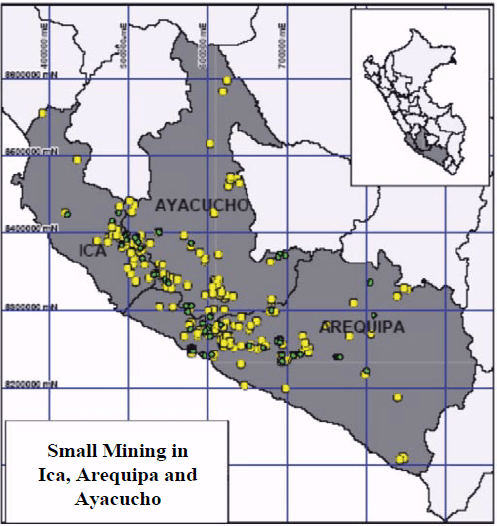
Figure 2: Informal Mining in Southern Peru
The map shown above comes from information taken from the Ministry of Energy and Mines (MEM) and includes 68 artesanal mining locations. The MEM database includes a total of 270 locations and even this is known to understate the actual number of small mining operations.
It is believed that less than one third of the mines are registered, or included in the reports of MEM. Therefore, the total material that is mined and treated is unknown. It is known, however, that the amount of informal mining activity has increased with the increasing gold price. This increases the mining potential of the zone.
Peru Small/Informal Mining Situation
Small mining in Peru is divided by MEM into two categories: traditional and artesanal. Not only is artesanal mining labour intensive with only rudimentary equipment, it is, also in general, an informal activity. Traditional mining makes use of mechanical technologies and is formally registered with the government following norms of labor relations, safety and mining hygiene, environmental requirements, the payment of taxes and reporting to the MEM. According to the statistics of the MEM, the artesanal mining contributes 14 % of the entire gold production of Peru.
Half of the national exports come from the mining and from 1998 the gold is the principal product of national exportation.
Beneficiation Plants
Only 5 plants in the study area use modern process equipment and can be considered to have acceptable reliability. These are shown on Table 2 below:
Table 2: Operating Plants

Plant Site Location
The geography of Peru is such that the coastal plain is entirely desert except in those areas in which rivers run westward out of the Andean highlands. The entire coast then is truncated every 100 kilometers or so by irrigated arid lands stretching a kilometer or two on either side of the river. The mining activities which are of interest to this report take place within the mountain barrier and usually at elevations below 3500 meters above sea level (masl). While the straight line distances from these mines to the coast are not large (less than 100 km) the steep nature of the terrain makes transportation of the mineral quite difficult and expensive.
This business plan proposes to locate the plant approximately 30 kilometers south of the city of Nazca at a distance of 500 meters along the PanAmerican Highway. The next step in development will be to apply for additional mining leases, purchase the mineral and surface rights to the plant site location and convert the lease underlying the plant to a beneficiation plant lease.
Infrastructure for the plant is excellent with water available from either a well on-site (50 meters) or via pipeline approximately 5 kilometers away. Construction to bring electrical power to within 2 kilometers of the site is underway and is currently 7 kilometers from the plant location.
A layout of the plant on the property will be developed as part of the engineering studies to be carried out prior to construction.
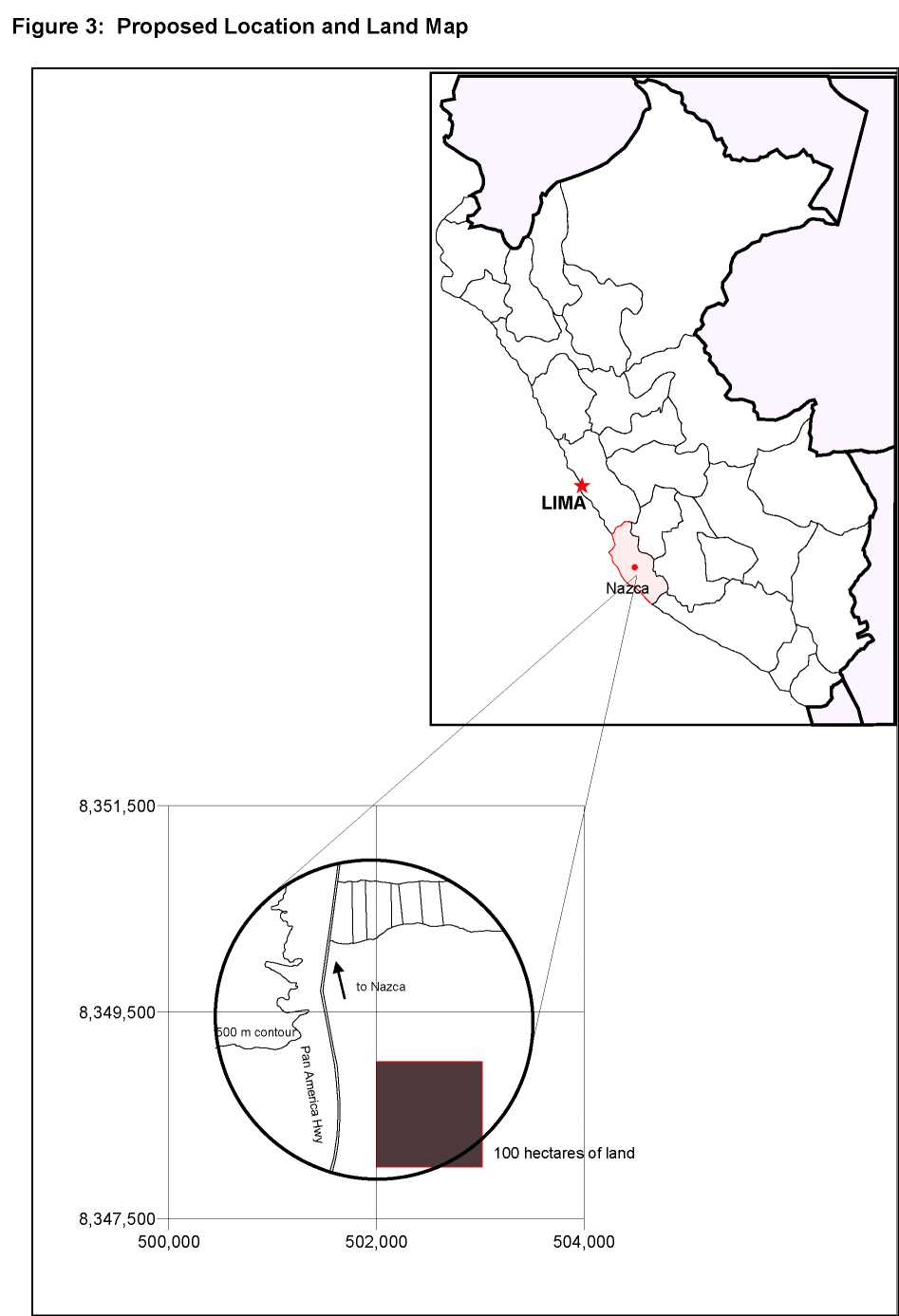
Small Gold Plant Design
A local metallurgical laboratory has completed 3 cyanidation tests to determine the optimum dosage of cyanide to recover the gold in ore from the Nazca-Ocona gold belt. The composite ore sample used had a head grade of 19 grams per tonne and the ore was leached for 48 hours with intermediate samples taken to determine the rate of gold dissolution. The results of this work are shown on Figure 4 below.
It is important to note that PTT intends to use the latest gold processing technology to ensure that all Peruvian regulatory requirements are met or exceeded. None of the technology to be used is experimental and all of the equipment required can be readily manufactured in a number of fabrication shops in Peru.
This test work forms the basis for the operating cost estimate and a preliminary flowsheet as discussed below. Based on other plant experience with this material and the preliminary bench scale testing that was done it was determined that a simple cyanidation plant would recover between 92 and 95 percent of the gold from the ore.
Process Testing
PTT obtained a 50 kilogram sample of ores from the Nazca-Ocona area and retained the private laboratory of TECSUP to undertake 3 cyanidation leach tests at different cyanide dosages. The report from this laboratory work is included in Appendix 1 to this document.
The grade of the 50 kilogram sample was 18.7 gpt of gold and the sample was pulverized to an 80 percent passing 200 mesh size consist for the testing. The three cyanide dosages used 0.5, 1.0 and 2.0 grams per liter and the consumption of cyanide after 48 hours was 3.06, 3.58 and 3.61 kilograms per tonne. If the material is leached for only 24 hours the recovery is essentially complete and the
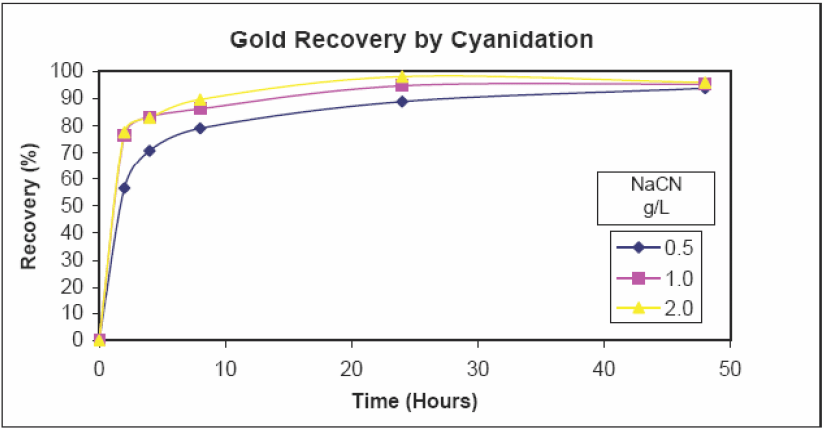
Figure 4: Process Test Results
consumption of sodium cyanide drops to 2.5 kilograms per tonne. The three samples were placed in a glass container and agitated for 48 hours. Twenty milliliter samples of the liquid phase were extracted periodically as shown to determine the rate of extraction and identify the optimal concentration of sodium cyanide. The results of the analysis are shown on the graph in Figure 4 below.
Plant Flowsheet
The standard process for this plant is shown on the preliminary flowsheet on Figure 5. The list of equipment is shown on Table 3. Ore will be brought by the miners to the plant in small trucks with an average size of 10 tonne lots and the material will be dumped on a compacted patio in a segregated bay. The material will be sampled and analyzed for gold grade, impurities and moisture allowing a fair assessment to be made of its value. The owner of the material will be paid on the basis of the analytical results. The method of payment is discussed below.
From the patio, the ore will be fed by small loader over a scalping grizzly and into a 60 tonne feed bin which discharges onto a screen. The screen oversize passes into a jaw crusher and the undersize passes by conveyor to a second screen. The discharge from the jaw crusher passes onto the same conveyor and also across the second screen. The oversize from the second screen goes to a cone crusher and the undersize passes by conveyor to a 150 tonne fine ore bin. Based on the granulometry of the material tested, less than 25 percent of the ore will need to be crushed.
The fine ore is taken from the bin via conveyor and discharged into a 7 foot by 7 foot ball mill. Water, lime and cyanide are added at this point. The ball mill discharge is pumped to a hydrocyclone with the underflow going back to the ball mill and the overflow feeding a 5 foot by 5 foot ball mill. The discharge from this ball mill is also sent to a hydrocyclone with the underflow going back to the ball mill and the overflow going to the first of four, agitated leach tanks.
The leach tanks work in series and by the time the solids pass through the fourth tank the gold has been leached from the fine solids. The slurry then passes into the first of three carbon-in-pulp tanks where fine carbon particles move in counter current with the slurry to absorb the gold laden cyanide solution. The slurry is pumped from the bottom of the third tank and sent to a standard tailings facility and the liquid phase is sent to the first of three desorption tanks.
The gold laden carbon is washed with stripping solution to remove the gold from the carbon and this solution is then sent to a small electrolytic cell where the gold particles are plated onto a gold cathode. The cathodes are periodically taken to a furnace and melted to make ingots of dore bullion. The carbon is washed with hydrochloric acid to regenerate its adsorption qualities and then sent to a rotary kiln to be reactivated and reused in the process. The sintered carbon is passed across a double deck screen to remove fine particles generated in the process. The fine
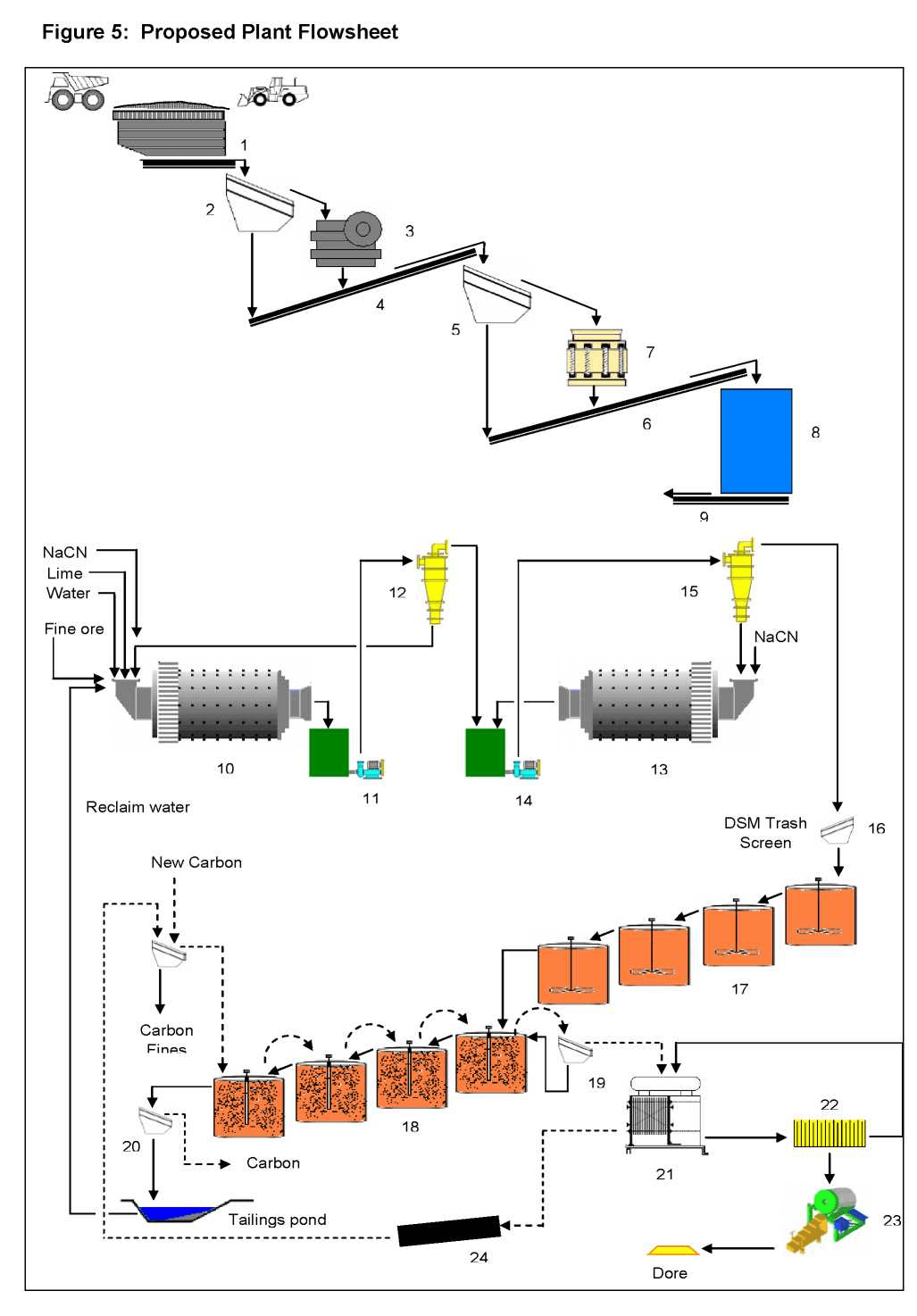
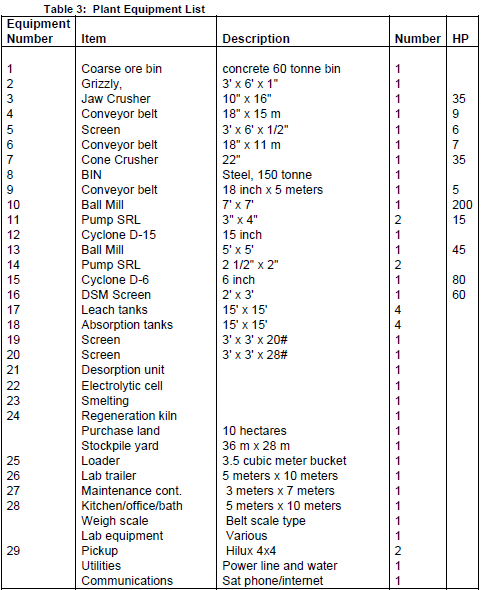
carbon which is removed will be stored for subsequent burning to capture any residual gold particles. The first step in the project process following financing will be to do more extensive metallurgical testing to finalize the process flowsheet and estimate an accurate mass balance. It is anticipated that several cost savings will be made at this point. For example the gold ore from the Nazca area is very highly oxidized and is delivered to the area plants with few rocks larger than 6 inches in size. It is not considered likely that much crushing will be required. Also the sizing of the ball mills will be more accurate and it is likely that smaller equipment will be used. The rapid reaction kinetics may allow for fewer tanks to be used. It is considered that the flowsheet presented in this business plan is conservative. The detailed design to be done post-financing will result in a target cost estimate and construction drawings.
Plant Cost Estimate
The cost estimate is based on a detailed budget quotation from a respected Peruvian plant fabricator. All equipment will be sourced Peru and the cost estimate is summarized below on Table 4.
The net result is a capital estimate accurate to within plus or minus 15 percent. Added to the installed equipment capital cost will be working capital to maintain an owner’s team during design and construction and to pre-purchase a one week supply of ore. The capital cost estimate quotation is included in Appendix 2 to this Business Plan.
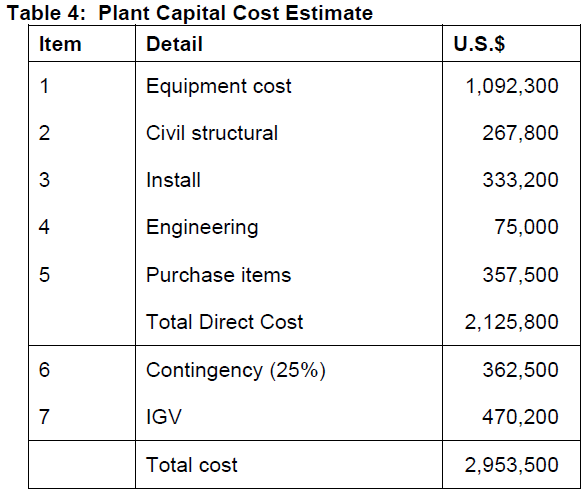
Discussions have been held with a reputable Peruvian engineering company with extensive experience in building this size and type of plant. Basic contract terms have been agreed upon pending financing. Their preliminary cost estimate to build the plant on a turnkey basis was less than this constructors estimate.
Plant Security
Security is an issue whenever there exists a small object of high value such as a brick of dore bullion. Security will be built into the plant design by surrounding the facility with a fence or wall and putting the final processing equipment into secured building. Workers will be required to wear company clothing and change and shower on site. Special traps will be built into all effluent discharges and private security will protect the plant.
The removal of gold bricks will be done under contract with one of the international, bonded security companies that operate in Peru and they will take custody of the gold at the plant site. There is a small asphalt airstrip at Nazca and flying the gold from this nearby town will be investigated. Plant security will be fully addressed in the detailed design stage following financing.
Plant Operating Cost Estimate
The plant operating cost estimate is developed from the power cost and reagent costs which are the largest cost items. Power requirement is determined by the horsepower requirements of the plant equipment and it is assumed that all power will be from the national power grid at a cost of US$0.10 per kwhr. A backup generator will be available in the event of power outages which are frequent in this part of the country. The plant operating cost estimate is shown on Table 5 below;
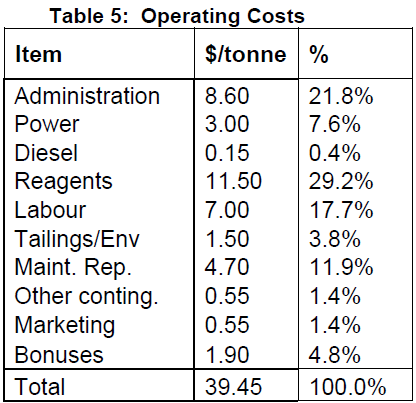
Plant Personnel
This manpower schedule assumes two, 12 hour shifts per day for 365 days per year requiring 3 shifts of personnel. The plant availability is assumed to be 95 percent resulting in 346 effective operating days per year. The labour cost shown in the operating cost estimate is based on this labour schedule assuming that qualified labour is paid $600 per month and tradespeople are paid $630 per month. The payroll burden is assumed to be 30 percent additional to the payment of 15 salaries in every 12 month period. Additionally a 6 percent profit sharing bonus is paid. The manpower complement at the plant is 21 operators, 8 technician/tradesmen, 3 shift supervisors, the plant metallurgist and the Operations Manager.
Fiscal Regime
The Peruvian fiscal regime is well understood and has been in place for the past 12 years. The recent election assures another 5 years of political peace and the ruling Aprista party is pro-mining and is not considering significant changes to this tax regime. It is emphasized that PTT will follow all Peruvian laws with respect to the paying of all tributes and taxes including payroll taxes and profit sharing and this is reflected in the cash flow model used in this Business Plan.
Income taxes
Income taxes are a flat 30 percent of resource revenue and most capital expenses are amortized straight line over a 10 year useful life. The lack of accelerated write-offs has been a topic of conversation between the mining industry and the government for some time but with commodity prices at high levels it is not considered likely that any changes will be instituted at this time.
Royalty Structure
Royalties are a new device in the Peruvian fiscal system and the graduated scale is dependent upon production rate at the mining face. As a result the plant will attract no royalties.
Proposed Development Schedule
The development schedule is shown on Figure 6 below. When the project has been financed there will be a one month design phase to confirm that the flowsheet is appropriate for the project. Fifty kilograms of ore will be obtained from the operations which have signed letters of intent for this purpose.
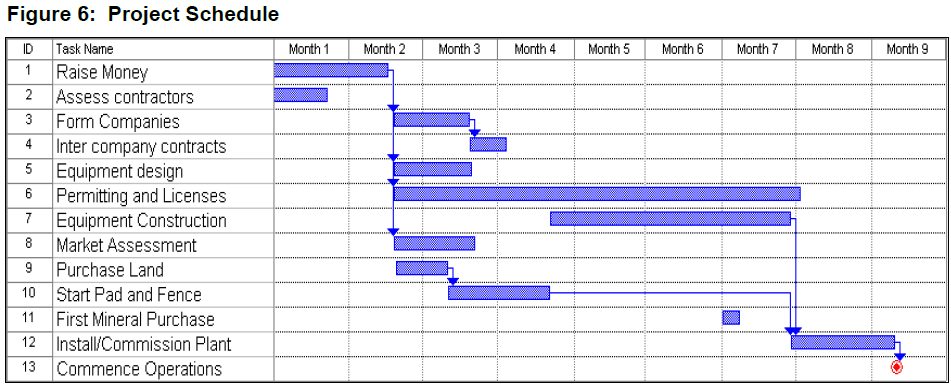
Discussions have already taken place with a local engineering company which has the competency for this project and they have expressed, in writing, their interest in providing a lump sum bid to engineer, purchase and construct the plant. Engineering of the plant will commence as soon as the design of the flowsheet is known in sufficient detail to start sizing the equipment. As previously stated, as much as possible, the plant will be built in modules which can be easily transported to the site and quickly interconnected. Plant engineering and purchasing is anticipated to take only 2 months as many of the contractors already have construction drawings for the equipment to be installed.
As soon as the equipment list is ready, orders will be placed for the components which will all be available locally. As each plant module is designed fabrication will commence. It is anticipated that construction of the plant will require 4 months.
All necessary permits will be applied for immediately following financing. These will include construction permits, water licenses and operating permits. A local consultant with specialized skills will be hired to write the necessary permitting documents and that the whole process will take from 3 to 5 months.
Management Team
A very high quality management team has been created comprised of well trained and experienced expatriates and Peruvians.
Cash Flow Analysis
The cash flow results are shown in Appendix 4 to this report and summarize the costs and revenues for a 10 year project life. The table shown assumes a gold price of US$1500 per ounce and a gradually increasing gold feed grade.
The revenue formula for the plant is based on two items;
1. A plant charge per tonne of throughput based on gold price.
2. A recovered gold payable equal to 90% of the total plant recovery. The company retains any gold recovery above 90%.
3. A marketing fee of US$20 per tonne.
When the gold ore is brought to the plant it will be evaluated and a purchase price assessed based on the average gold price of the previous 7 trading days, the ore grade and moisture content and the plant revenue factors identified above.
The processing charge was calculated from an understanding of the process charges for the major competitor to PTT. While not wanting to upset the current pricing regime, PTT will be at or below the competition at any given gold price. Note that this calculation is based on pricing at a time when the gold price was $450 per ounce. It has moved up since this time and the economics presented are based on an increase of $20 in the process charges shown below. The deviation from our competition widens as the gold price increases as shown in Figure 7 below. For clarity, this figure shows the amount paid to the sellers of the ore and is not the amount paid to the plant.
The processing fee floor value was determined from a supply cost analysis at a gold price of US$300 per ounce and a grade of 10 grams per tonne. It was determined that a charge of US$54 per tonne of ore is required to obtain a 25% rate of return on the project (at a gold price of US$300 per ounce).
Based on this analysis, the processing charge is calculated according the following formula;
Processing Charge (US$/t) = -0.0074 x gold price² + 1.6411 x gold price + 58.27
The operating cost has been described above and the cash flow analysis uses this cost with an additional 4% for marketing and head office administration. As gold prices have topped $1500 per ounce and additional $20 per tonne was added to this processing charge.
Two written expressions of interest have been received from concession owners who have mines currently not operating. PTT have visited the Erika mine and confirm that it is capable of producing 350 tonnes per day of gold mineralization. The total production being offered by the two formal mining companies is 450 tonnes per day.
Taxes and royalties are as described above. The capital cost allowance for all capital requirements is assumed to be a 10 percent, straight line deduction for 10 years (the assumed life of this project).
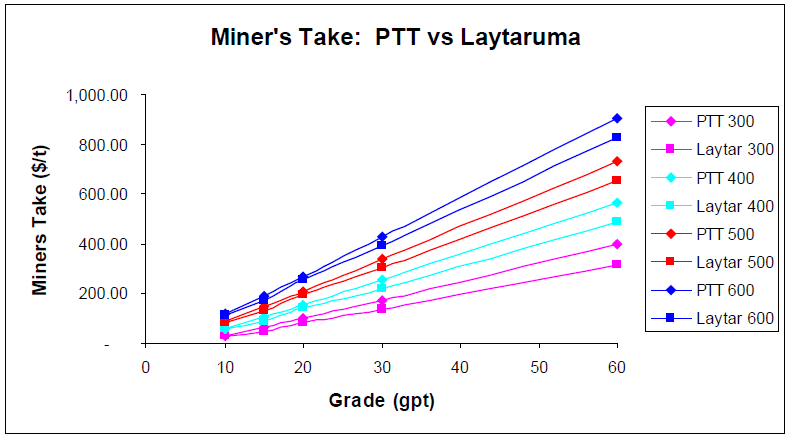
Figure 7: Comparison to Competitor Plant
The net cash flows are then calculated as shown in the Appendix and, for this base case production scenario, the project net present value at a 10 percent discount rate is $22,000,000, the rate of return is over 200% and the payback period is 1.1 years. Figure 8 indicates the expected net present values at varying discount rates for the base case cost and revenue assumptions.
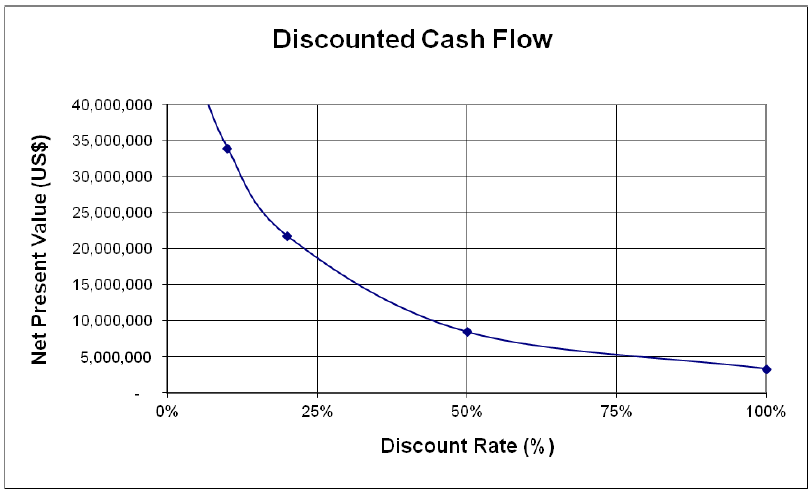
Figure 8: Net Present Value at Varying Discount Rates
Sensitivity Analysis
A sensitivity analysis for the project has been undertaken as shown on the spider diagram in Figure 9. The input values of gold price, operating cost and capital cost have been varied in 25% increments from 25% of base case to 175% of base case values. The slope of the criterion lines indicates how sensitive the project economics are to changes in these criterion – the steeper the line the more sensitive the project economics are to that variable.
It can be seen from this sensitivity analysis that the project is extremely robust and is largely indifferent to capital cost nor very sensitive to gold price as most of the plant revenue comes from the processing charge.
As expected the project economics are most sensitive to mineral grade and PTT will pay particular attention to its product mix in order to get access to the highest grade and cleanest ores.
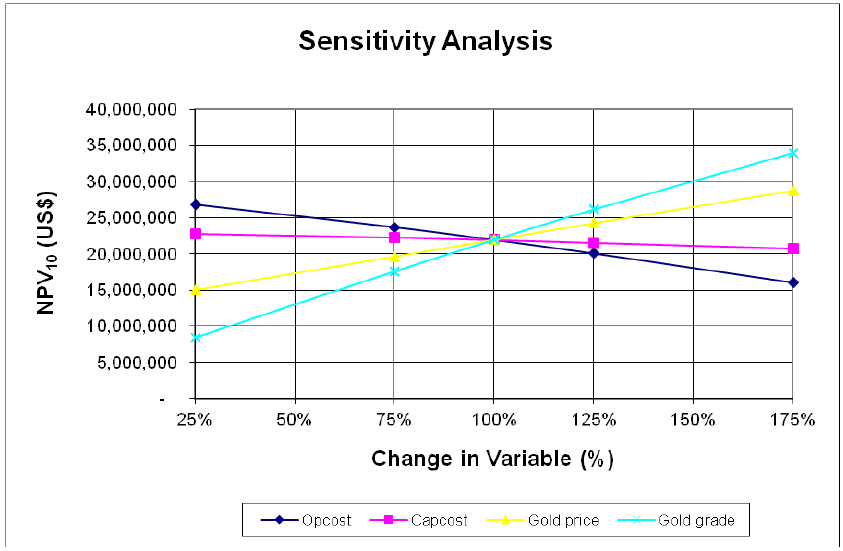
Mining Project Risks
While the project demonstrates excellent potential economic returns it is not without its risks. These are discussed below;
The plant does not effectively separate the gold:
The technology for winning gold from these types of ores is well understood and there are other much older and quite dilapidated plants operating successfully in the area. It can be seen from the economic sensitivity analysis that the project remains economic even with significant changes in capital and operating costs. When capital and operating costs are at 175% of the base case ($4,200,000 and $58.00 per tonne) and the ore grade and gold price are at 50% of the base case values (10 grams per tonne and $325 per ounce) the project will have an NPV10 of $3,682,000.
There is not enough ore to meet the throughput design
As stated previously, 14% of all the reported gold produced in Peru comes from small scale and informal miners. With high gold prices there are literally thousands of small miners operating in the area of interest and there is not enough plant capacity for them. Currently, a “miner’s cooperative” is being created to subsequently sign an agreement with the writers of this Business Plan.
The plant will not compete on the basis of pricing but rather on the honesty of its operation. The small miners will be given full value for their ore as determined by a third party, internationally recognized laboratory – which is not currently the case. As well the plant site is located within 1 kilometer of the main Peruvian highway while the competitors plant is located approximately 2 hours from the highway along a difficult, narrow gravel road. The plant location will guarantee a continuous supply of feed stock.
The plant workers rob from the company
Plant management has been chosen with great care and special attention will be taken to hire only qualified and reputable people. The company will also contract the services of a reputable firm to periodically audit the operations for shrinkage.
There is no backout strategy for the investors
While the initial money is being raised privately it is anticipated that within 2 or 3 years of startup the company will be taken public.
There is political instability in the country
The new regime in Peru has announced that it is committed to maintaining a pro-mining position while directing additional social development funds to the outlying regions of the country. Recently the government announced that informal miners must follow the same environmental guidelines of formalized mining companies. The best insurance against fall-out from such political instability is to maintain a very low business and community profile. This area of Peru is also known for being relatively peaceful and stable thanks to the self-organizing activities of the informal miners. While they do not operate under the aegis of Peruvian mining codes and laws they do an excellent job of protecting their own interests. The World Bank has specific programs to reduce the use of mercury in artesanal gold operations and will be supportive of this plant.
The signing of free trade agreements with Canada and the United States will do a great deal to normalize Peruvian business conditions in order that they are aligned with North American practices thus stabilizing the business climate.
This mining business example was created in 2010 – Some data might be out-of-date.

